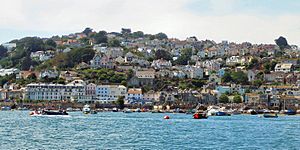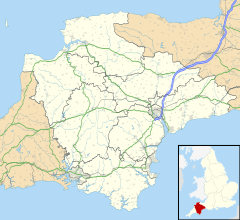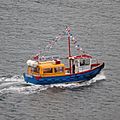Salcombe facts for kids
Quick facts for kids Salcombe |
|
|---|---|
 Salcombe waterfront |
|
| Population | 1,909 (2011 census) |
| OS grid reference | SX7339 |
| District | |
| Shire county | |
| Region | |
| Country | England |
| Sovereign state | United Kingdom |
| Post town | SALCOMBE |
| Postcode district | TQ8 |
| Dialling code | 01548 |
| Police | Devon and Cornwall |
| Fire | Devon and Somerset |
| Ambulance | South Western |
| EU Parliament | South West England |
| UK Parliament |
|
Salcombe is a popular resort town in Devon, south west England. It sits near the mouth of the Kingsbridge Estuary. Most of the town is built on the steep west side of the estuary. Salcombe is part of the beautiful South Devon Area of Outstanding Natural Beauty (AONB).
The town's long waterfront and natural harbour helped it become successful. It was once a busy place for building boats and shipbuilding. Today, it's a top spot for sailing and tourism. Many people visit for pleasure boats and yachting. Salcombe also has a traditional fishing industry, especially for shellfish. In 2011, the population of Salcombe and nearby Malborough was 3,353.
The Kingsbridge Estuary is actually a "ria," which means a drowned river valley. It stretches about 8.6 kilometers (5.3 miles) inland. This estuary is a special natural area. It was named a Site of Special Scientific Interest in 1987. It is also a Local Nature Reserve.
Contents
History of Salcombe
Ancient Shipwrecks
Several old ships have been found off the coast of Salcombe. The oldest is a Bronze Age ship. It carried weapons and jewelry from what is now France. This is one of only three such ships known in Britain. The Salcombe Cannon Wreck is from the 1600s. It held 400 Moroccan gold coins and Dutch items.
In 1936, a large Finnish sailing ship called Herzogin Cecilie ran aground. It was later moved to Starehole Bay. Also near Salcombe is HMS Untiring. This World War II submarine was sunk in 1957 for sonar practice.
Early Records and Fishing
The area around Salcombe was mentioned in old records from the 800s. The name "Salcombe" first appeared in 1244. By 1570, there were 56 sailors living in Salcombe. Just two years later, records show five ships under 60 tons.
In 1566, ten large fishing nets were used in Salcombe. In the 1580s, Salcombe fishermen traveled to Padstow every year. They went there to fish for herring.
Fort Charles and the Civil War
The ruins of Fort Charles can still be seen south of the town. King Henry VIII had it built to protect the estuary. During the English Civil War, Salcombe supported the Royalists. From January to May 1646, the fort bravely held out against the Roundheads. It was the last Royalist stronghold to surrender. After the war, Parliament ordered the fort to be destroyed.
There is not much information about Salcombe between 1650 and 1750. People likely made a living by fishing and smuggling. In 1764, the first holiday home, The Moult, was built in Salcombe.
Shipping and Shipbuilding
In the 1800s, Salcombe became a major center for the fruit trade. Salcombe ships sailed to Europe, the Mediterranean, and the Caribbean. They brought back oranges, lemons, and pineapples. Other goods included sugar, rum, and coconuts. They also brought wood like ebony and mahogany for building ships.
Salcombe and Kingsbridge were busy places for building ships. They produced the "Salcombe schooner." This was a fast boat that needed only a few sailors. However, nearly half of these ships were lost at sea. In 1811, a group was formed to help insure Salcombe ships.
The Salcombe fleet also traded along the coast. They brought coal from Wales and took away cider, grain, and slates. A ferry service to Brest, France, started in 1870 but did not last long.
By 1871, Salcombe had 776 people. Many worked in shipbuilding, including 34 shipwrights. However, in the 1870s, the fruit trade slowed down. This was due to fruit diseases and the rise of steamships. Some ships found work carrying salt to Newfoundland and bringing back cod. But by 1914, only a few trading ships were left. Around this time, pleasure sailing became popular in Salcombe. The yacht club was founded in 1894.
Salcombe became a port for registering ships in 1864. Between 1796 and 1887, at least 200 vessels were launched from Salcombe. Shipyards were expanded by adding land to the foreshore. Many Victorian houses in Salcombe were built by shipowners and captains. After 1880, with bigger steamships, there was less new building. Many Salcombe sailors and workers moved to larger ports.
A new road to Salcombe was built in 1824. The town's population grew from 972 in 1841 to about 1500 by 1850.
Salcombe as a Holiday Resort
Between the two World Wars, Salcombe grew as a holiday spot. Salcombe Sailing Club was founded in 1922.
During World War II, a radar station was set up at Bolt Head. Salcombe became an important base for the United States Navy in 1943. The Salcombe Hotel became their headquarters. Many other buildings were used, and special huts were built. New quays and slipways were also constructed.
On June 4, 1944, 66 ships sailed from Salcombe. They were part of "Force U" for the Normandy landings on Utah Beach. After the landings, damaged landing craft were repaired in Salcombe. The base closed in 1945. A plaque in Normandy Way remembers the United States Navy. Salcombe also experienced some bombing raids during the war.
The old radar station at Bolt Head was later planned as a government shelter during the Cold War. It has since been taken down. After World War II, the Salcombe waterfront changed a lot. A new car and boat park was built, along with a road to Batson.
Marine Facilities and Activities
Salcombe Harbour
The Salcombe harbour is managed by the local council. This means it's a public port. The council can build, manage, and improve the harbour. They can also charge fees for its use. In 2014, the harbour received "Eco-Port" status. This means it meets high environmental standards.
The Bar and Lifeboat Station
Near the mouth of the estuary is "The Bar." This is a sand spit that appears at low tide. When the tide is low and strong winds blow from the south, crossing The Bar can be dangerous.
It's believed that Lord Tennyson's famous poem "Crossing the Bar" was inspired by Salcombe. The poem talks about the "moaning of the bar." This refers to the sound of water breaking over The Bar.
The Royal National Lifeboat Institution (RNLI) set up Salcombe Lifeboat Station in 1869. In 1916, the Salcombe lifeboat, an open rowboat, capsized while crossing The Bar. Thirteen of the 15 crew members lost their lives. However, a new crew quickly formed. The station still operates today. It has a large all-weather boat and a smaller inshore boat. The original lifeboat station is now a museum and shop in Salcombe town.
Beautiful Beaches
On the east side of the estuary are several popular sandy beaches. These include Sunny Cove, the large Mill Bay, and Cable Cove. Cable Cove is where an underwater communication cable lands. Small's Cove and Fisherman's Cove are also nearby. A ferry runs from Fisherman's Cove to East Portlemouth. From there, you can access the South West Coast Path.
On the west side of the estuary are South Sands and North Sands beaches. A scenic ferry runs between Salcombe and South Sands. A special "Sea Tractor" helps passengers get from the boat to the beach. South Sands beach has won the Blue Flag Beach award many times. North Sands and Mill Bay beaches are also very clean.
North of North Sands, Salcombe town begins. It spreads along the west side of the estuary. The town also extends into nearby creeks like Batson Creek. Other creeks, like Southpool Creek, branch off to the east. The main channel continues to Kingsbridge. A larger ferry runs in summer between Salcombe and Kingsbridge when the tide allows.
Sailing and Water Sports
Salcombe harbour is mainly used for fun and recreation. It hosts about 1600 local yachts and power boats. Around 6,000 visiting boats come each year. There are no large commercial ships here. This is because The Bar at the entrance limits how big boats can be.
The estuary is a calm place for many water activities. These include paddleboarding, kayaking, and yacht and dinghy sailing. Racing is also popular. Many people enjoy swimming from the beaches. The harbour even inspired its own type of dinghy, called the Salcombe Yawl.
Salcombe Sailing Regatta
Salcombe Yacht Club hosts a big regatta every August. It attracts up to 400 dinghies in many different classes. The Salcombe Yawls are a special part of this event. They were designed and built in Salcombe using traditional methods.
Salcombe Town Regatta
The Salcombe Town Regatta is the busiest week of the year. It's full of family-friendly events. These include mud races, a cross-harbour swim, and fun runs. There are also rowing races, a swimming gala, and sandcastle competitions. Other activities include fishing, treasure hunts, and crabbing. The week ends with fireworks, a Crabbers Race, and a torchlight parade. Children's sports, a family fun day, and a fancy dress parade are also popular. Sometimes, the Red Arrows even perform over the estuary!
Economy
Salcombe is known for its beautiful scenery, sandy beaches, and great sailing. Because of this, property prices in Salcombe are very high. Many shops, bars, and restaurants cater to visitors. They offer fashionable items and nautical gear.
Salcombe has many boatyards and marine stores. Boats are stored in the car park by the fishing quay during winter. There is also a power boat school. SCUBA diving is popular, but you need permission from the harbour office first. The town and yacht club regatta weeks are highlights of the summer.
Fishing is still important in Salcombe, especially for shellfish. About 2,000 tons were caught each year between 1986 and 1990.
The Marine Hotel was bought in 2012 and became the Salcombe Harbour Hotel. It cost about £12 million to transform. Fourteen villas and apartments were built in front of the hotel. They were sold for £1.2 to £2.85 million. Some are used by owners, while others are rented for holidays.
Popular stores in Salcombe include Fat Face, Joules, Musto, Henri Lloyd, and White Stuff. The fashion brand Jack Wills started in Salcombe in 1999. Salcombe is also home to Cranches, the oldest sweetshop in Devon.
Media
Local news and TV shows come from BBC South West and ITV West Country. Radio stations include BBC Radio Devon, Heart West, and Greatest Hits Radio South West. The local newspaper, Kingsbridge & Salcombe Gazette, is published on Fridays.
Facilities
Salcombe has narrow streets, and pedestrians are given priority. So, a park and ride service runs from the edge of town in summer. In winter, it's a "park and walk" system. A small airfield, Bolt Head Airfield, is located southwest of town. It was once RAF Bolt Head during World War II.
The Salcombe Maritime Museum opened in 1975. It has information about the old fruit schooners and other interesting items. The museum is on the ground floor of the former council offices. Each summer, they have temporary exhibitions.
Near South Sands is Overbeck's, a house and gardens owned by the National Trust. Inside the house, you can see inventions by Otto Overbeck.
Salcombe has many walking routes nearby. It is on the South West Coast Path. It is also on National Cycle Network route 28. Other facilities include a gin distillery called Salcombe Gin.
Sports in Salcombe
Salcombe Primary School has a 20-meter outdoor heated swimming pool. It is open during the summer. The rugby club is a center for activities in winter. Salcombe Town Football Club, re-formed in 2010, plays its home games in nearby Malborough.
Sailing Facilities
Salcombe offers many facilities for visiting boats. These include a fuel barge, showers, and drinking water.
Gallery
See also
 In Spanish: Salcombe para niños
In Spanish: Salcombe para niños










